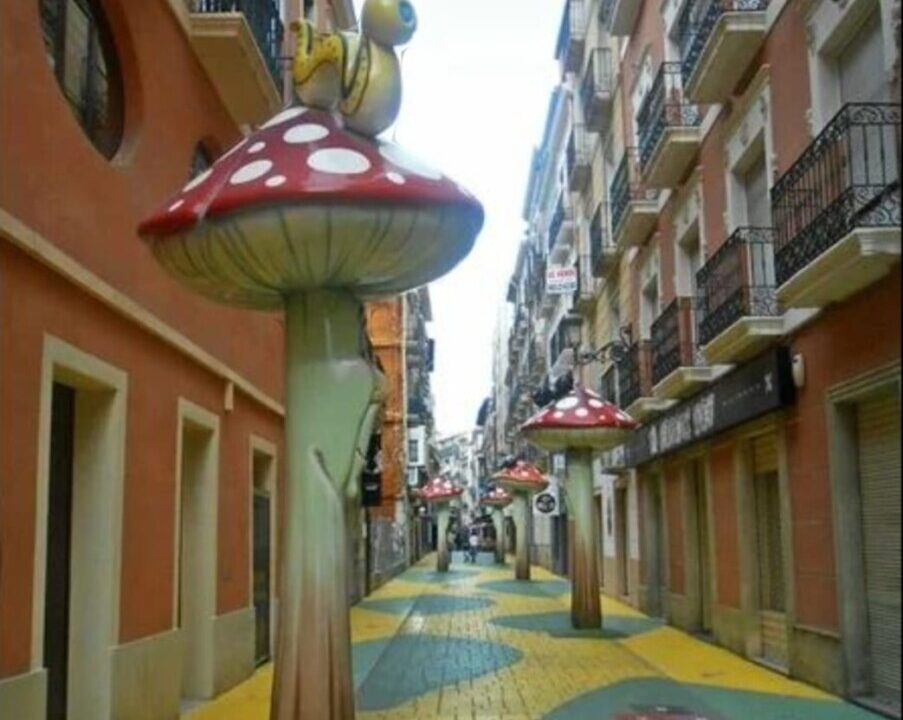
In the center of the sunny city of Alicante, in the south of Spain, lies one of the most unusual and colorful streets, the Street of Mushrooms (Calle de las Setas). This place has become a landmark for residents and tourists due to its fairy-tale decoration and an atmosphere that combines playfulness, art and childlike joy. The official name of this street is Calle San Francisco, but since 2013 it has been informally named “Mushroom Street” due to the decorative elements that adorn this pedestrian zone.
Creation story
The idea of turning San Francisco Street into a magical place with giant mushrooms came about as part of a city beautification project. The Alicante administration wanted to breathe life into the old city neighborhood, which until then had not attracted much attention from tourists and locals. In the early 2010s, a plan was outlined to create a colorful and creative street that would become a cultural and tourist attraction.
The street was decorated in 2013 as part of the city center modernization program. Colorful sculptures of giant mushrooms and other fantastic objects were installed along the entire street. These decorations were meant to resemble a fairy-tale world where adults and children can distract themselves from everyday worries and plunge into magic.
The uniqueness of Mushroom Street
1. *Fairytale atmosphere*. One of the most notable features of the street are huge mushrooms up to several meters high, which are covered with images of smiling ladybugs, butterflies and other forest creatures. In shape and style, they resemble fairy-tale decorations, giving the impression that you are in a children’s book or cartoon. These mushrooms are not only decorative, but also interactive: some of them are equipped with buttons that turn on light or sound, attracting children’s attention.
2. *Pedestrian Convenience. Mushroom Street is a fully pedestrianized area, making it ideal for leisurely strolls. Here you can take a quiet stroll, look at the bright installations and take photos against the colorful objects. Many benches and cafes along the street allow you to relax and enjoy the atmosphere of the city.
3. *A place for family vacations. This street is especially popular with families with children. Giant mushrooms, fun characters and lots of details make a walk down the street a real adventure. Kids can interact with the surrounding space, making Mushroom Street one of the favorite places for family fun.
4. *Cultural and tourist significance. Thanks to its unusual design, the street quickly gained popularity among tourists and became a must-see attraction. Various city events, festivals and street performances take place here, attracting the attention of both locals and visitors.
Architectural and artistic features
The outdoor decorations are made in the Art Nouveau style, which adds to its aesthetic appeal. Mushrooms, fairies, insects and other decorative elements are made with a high level of detail, making each sculpture unique. Soft shapes, flowing lines and bright colors emphasize the playfulness and surrealism of the street.
Mushrooms and other sculptures not only decorate the street, but also help to create a kind of alley of wonders. Some mushrooms even act as a kind of lanterns, illuminating the street in the evening with a soft light, which gives it an additional charm.
Economic and tourist impact
The creation of the Mushroom Street has proven to be a successful project for the city of Alicante. It has become a point of attraction not only for locals but also for tourists from all over the world. San Francisco Street, previously a little-known and secondary street, after its transformation into Mushroom Street has become one of the most visited places in the center of Alicante. This, in turn, encouraged business development: numerous stores, cafes and restaurants sprang up along the street, bringing additional income to the city coffers.
Influence on the urban image
Mushroom Street has become a symbol of the new wave of urbanism in Alicante. It demonstrates how creativity and unusual design solutions can transform urban space, make it attractive to different categories of people and inspire further change. This project has inspired other cities in Spain and Europe to create similar art spaces that bring together culture, art and architecture.
Conclusion
Mushroom Street in Alicante is more than just a pedestrian zone with colorful installations. It is a place where art and architecture merge with everyday life, creating a unique atmosphere for all who choose to stroll down this fabulous street. The mushrooms on San Francisco Street have become a symbol of creativity and a new approach to urbanism, and the street itself is an important part of Alicante’s cultural and tourist heritage.

